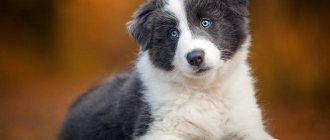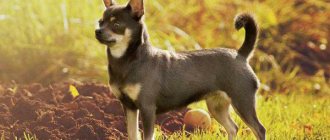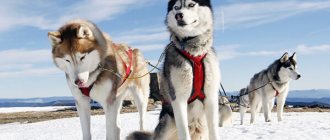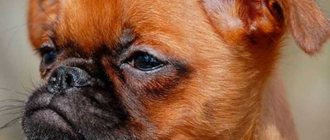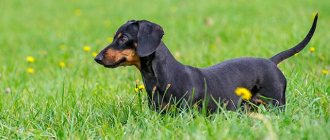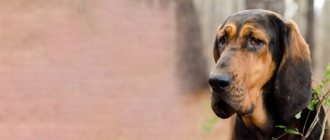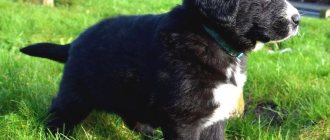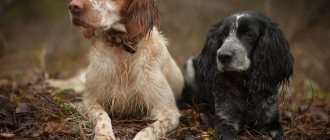Brief history of origin
Germany is considered the homeland of miniature schnauzers. The history of the breed began in the 18th century. At that time, medium-sized schnauzers were popular in Germany, and German breeders wanted to create a dwarf copy of them. To achieve this goal, Mittels were crossed with poodles, Spitz and Affenpinschers.
There is also an assumption that some small terrier took part in the formation of dwarf schnauzers. When the first puppies were born, it turned out that the change in size affected the color of the dogs.
It took additional time to resolve the issue of coat shade, and the presentation of miniature schnauzers took place only in 1888.
Interesting! The first dwarf schnauzers came to Russia about 40 years ago. Breeding miniatures in the Russian Federation began in 1980.
Interesting Facts
During the short period of existence of dwarf schnauzers, a lot of interesting things happened to this breed:
- Miniatures are among the ten most popular dogs in the world.
- Miniature schnauzers still successfully serve in the police and customs.
- The name of the breed fully conveys the exterior features of the dogs. Translated from German, it means “mustachioed gnome” (schnauzer – barbel, zwerg – gnome).
Expert opinion
Leonid Rodin
Experienced dog breeder
Ask a Question
The smallest of the schnauzers is often classified as a terrier, but this is absolutely not true. The confusion stems from the fact that the American and Canadian cynological associations placed them in this section. Miniature schnauzers were indeed used for some time to hunt small burrowing rodents, but they did not achieve much success in this matter. They simply lack the level of aggression that necessarily characterizes a true game hunter. But in other areas that require acquired rather than innate skills, these four-legged natives of Germany are very successful. The fact is that in terms of intelligence level in the dog rating, the miniature schnauzer is in 12th place. He turned out to be smarter than his larger relatives. According to the criterion of trainability, the standard schnauzer took 22nd place, and the large giant schnauzer even further, in 35th position. So the popularity of the miniature nauzer is largely based on its remarkable abilities. Miniature Schnauzers can often be found in the company of movie and pop stars. And American Senator Bob Dole and his wife once threw a grand party on the occasion of their beloved dog’s 13th birthday. 16 of her friends came to visit the dog named Leader. And all of them, naturally, were four-legged, toothy and vocal.
Description of the breed, standards and appearance of the miniature schnauzer
The Miniature Schnauzer has common features with the Miniature Schnauzer and is its exact copy. Related dogs differ from each other only in size. The first breed standard for the Miniature Schnauzer was adopted in 1890. Later, the document was changed several times. The last adjustments to the official description of the miniature schnauzer were made in 2007.
According to FCI standard No. 183, the miniature should look like this:
- The dog's elongated head is proportional to its overall build. The muzzle is in the shape of a blunt wedge. The occipital protuberance of the miniature schnauzer is pronounced, the stop is clearly visualized and limited by the superciliary arches.
- Wide, strong jaws with a full set of teeth close into a scissor bite. Overbiting or underbiting a miniature schnauzer is unacceptable.
- Oval dark eyes of medium size. Located close to each other.
- The high-set ears of the Miniature Schnauzer are V-shaped, often 2/3 cropped. In this case, they stand facing away from each other.
- The body is square, stocky, high forward. The neck is muscular, withers are pronounced. The back is short, the chest is deep, the stomach is moderately tucked.
- The limbs are muscular and erect.
- The crescent-shaped or saber-shaped tail of the miniature is a natural continuation of the rounded croup. Often stopped by 2/3.
The miniature schnauzer, whose birth weight is 150-250 g, quickly gains weight. By the age of one month, the puppy weighs 700-110 g. And by the age of one year, the weight of the miniature reaches 6-8 kg.
Miniature Schnauzer height and weight table by month:
| Age, months | Floor | Height, cm | Weight, kg |
| 2 | M | 20-21 | 2,1-2,5 |
| AND | 18-20 | 1,8-2,1 | |
| 4 | M | 31-33 | 4,5-5,5 |
| AND | 27-30 | 3,5-4,0 | |
| 6 | M | 31-34 | 5,8-6,5 |
| AND | 31-32 | 4,0-5,0 | |
| 10 | M | 34-35 | 7,0-7,5 |
| AND | 32-33 | 5,0-5,5 |
Another important characteristic of the breed is the movement of the dwarf schnauzer. They should be elegant, loose, elastic and wide. The Miniature Schnauzer has strong ligaments and joints.
The dwarf dog moves with a springy step with a good extension of the front limbs and a strong push of the hind limbs.
On a note. In the Miniature Schnauzer dog breed, a deviation in height of more than 2 cm from the upper or lower limit provided for in the standard is unacceptable.
In the Miniature Schnauzer breed there is no official division into groups depending on any parameters of the dog.
Color and coat type
The compact body of the miniature is completely covered with a thick, hard spine that resembles a wire. Hidden underneath is a dense undercoat that protects the dog from the cold.
The main feature of the Miniature Schnauzer is the presence of a beard, bangs and eyebrows on the face, as well as feathering on the paws. The standard allows for the existence of several colors.
Read more about the colors of the breed in this article.
In addition to the most popular black color, the breed also contains:
- black with silver;
- pepper and salt;
- white.
Many people confuse pepper with salt and black with silver. In fact, there is a significant difference between them:
- In the first case, the dwarf schnauzer's coat is colored in different shades of gray, white and black.
- In the second, on the main black background there are light areas localized above the eyes, on the paws, chest, beard and cheeks of the miniature.
Possible disadvantages
In the description of a miniature schnauzer, the following are considered non-compliances with the standard:
- Round and massive skull;
- Folds on the body;
- Muzzle that is too short or excessively pointed and elongated;
- Elongated, curved back;
- Long, soft, wavy coat;
- Imperfect bite, yellow and sparse teeth, presence of caries;
The presence of pathological nervousness, suspicion, uncertainty and timidity, as well as excessive aggression.
Character and behavior
Despite the modest size of miniature schnauzers, they have all the qualities of a real servant. Serious, vigilant dogs with a stable psyche and lightning-fast reactions are distrustful of strangers and cope well with the functions of a watchman.
The individuality of the miniature schnauzer's character is based on the contrast in the dog's behavior. Cunning and resourceful dogs are real sneakers. Miniature Schnauzers often put on a serious appearance. But at any moment the dogs are ready to take part in the general fun.
Friendly miniature schnauzers treat all members of the owner's family equally well, but do not get along well with cats and small pets.
Breed and children
Miniatures get along well with children. Miniature dogs love to play catch with them or just run around the park. Loyal and brave miniature schnauzers often become not only wonderful companions for children, but also true protectors.
How to choose the right puppy?
In Moscow and other large cities it is not a problem to buy a miniature car. To be sure of the purebred dog, it is better to contact a kennel that specializes in breeding dwarf schnauzers.
You should definitely check the presence of all the necessary documents, look at the conditions in which the children are kept and look at at least one of their parents.
It is also important to pay attention to the behavior of the puppies. The little miniature should be curious, sociable, not cowardly and without signs of aggression. A healthy Miniature Schnauzer puppy is indicated by clear skin, clear eyes, a soft belly and pink gums.
Selection rules
It is best to purchase a miniature schnauzer from a nursery or from a breeder with a good reputation. And it doesn’t matter whether you just want to make a friend and companion, or dream of championship titles. The presence of reliable, correctly executed documents is of great importance not only for the owner, but also for the dog itself.
You can buy miniature schnauzer puppies as early as two months old, but for exhibitions it is better to make a choice later - after the litter reaches 6 months of age.
You need to pay attention to the activity, cheerfulness, curiosity of the puppy, its fatness (it should be moderate), the shine of its fur, the cleanliness of its eyes and ears. There should not be any subcutaneous bumps on the dog’s body (a bulge between the shoulder blades is possible - this is a temporary reaction to the vaccination).
It is important that the dog does not show aggressiveness when playing - however, males have more developed fighting qualities, and their constant desire to “hang out” with someone is the norm.
The puppy’s parents should be vigilant and restrained, and the baby himself should not bare his teeth at the future owner, be friendly, show interest in him and be ready for contact.
- A purebred puppy costs at least 18,000 rubles, and according to documents, the exterior of its parents is assessed as good and very good.
- There are usually no champions in the pedigree of such dogs. A titled miniature costs from 25,000 rubles, but this does not guarantee that he will necessarily be a winner of various competitions - a lot depends on the training, upbringing, care and maintenance of the dog.
If the miniature schnauzer receives love, attention and care, then he will demonstrate his best qualities every day.
Caring for puppies
Miniature Schnauzer puppies are curious creatures that actively explore the world. They try everything and can cause harm to themselves. To protect the miniature schnauzer, all wires and small or valuable items are removed in advance from the apartment where the dog will live.
From the first days, the little miniature is taught to a certain routine and rules established in the family. At first, the miniature schnauzer puppy will go to the toilet in the house, so he is given a corner covered with newspapers or diapers. After the end of quarantine, the vaccinated miniature is retrained to relieve himself on the street.
Before purchasing from a breeder, it is better to ask what to feed your miniature schnauzer. It is advisable to accustom the puppy to new food gradually, so as not to provoke stress in the baby.
The number of feedings depends on the age of the miniature:
- up to 8 weeks – 6 times a day;
- 2-3 months - 5 times a day;
- 4-6 months – 4 times a day;
- 7-11 months - 3 times a day.
A one-year-old miniature schnauzer is given food twice a day.
Food
Meals should be four times a day for up to four months, three times a day for six months, and two meals a day after eight months. The diet should not contain sweet, smoked or spicy foods. You cannot feed a dog from the table - the miniature can make a pitiful look, but this is just a cunning attempt to manipulate the owners.
- If you take ready-made food, then the best is premium and super-premium especially for small dogs.
- Natural products are also needed, but they should not be mixed with food. The diet should be based on meat, offal and cereals.
It is important to have boiled sea fish, fermented milk products (low-fat), yolk, and seasonal fruits.
Care and maintenance of an adult dog
The miniature is not suitable for enclosure life. And it’s not so much the smallness of the dog, but the dislike of loneliness. A miniature schnauzer, deprived of the attention of its owners, begins to get bored and may become depressed.
Caring for a miniature dog is no more difficult than caring for a dog of another breed. The main thing is to teach the dog a calm attitude towards the necessary procedures from an early age.
Caring for a miniature schnauzer comes down to proper feeding, regular walking and basic hygiene.
The right diet
The owner independently decides what to feed the miniature schnauzer. When choosing the type of food for your dog, you should be guided by your own convenience. While eating, miniatures often get their beard and mustache dirty. Therefore, among the owners of dwarf schnauzers there are many fans of ready-made food.
Drying for miniatures should be premium or super premium.
It is important that the dog food does not contain corn, soy, wheat, preservatives, dyes or other dubious additives. The daily drying rate is determined according to the table on the packaging, taking into account the age and weight of the schnauzer.
On a note. The best dry food for miniature schnauzers are RoyalCanin, ProPlan, Acana and Josera. Each of them contains the entire set of vitamins and microelements necessary for a dog’s health.
With a natural type of feeding, the diet is designed so that the following products are present in the miniature’s menu:
- meat (poultry, beef or lamb);
- vegetables (zucchini, pumpkin and carrots);
- offal (beef liver, heart and tripe);
- cereals (rice, buckwheat and oatmeal);
- fermented milk products (kefir, yogurt and cottage cheese);
- sea fish;
- eggs.
You cannot feed your dwarf schnauzer pork, potatoes, onions, baked goods, sausages and chocolate. Salty, spicy, smoked, fatty and fried foods are not suitable.
Leftovers from the master's table are also not the best food for a miniature schnauzer.
On a note. The miniature dog should not be overfed. Regular overeating leads to excess weight gain, which can cause health problems.
Walking and physical activity
The little miniature is by no means a decorative house dog, willing to wear a diaper and lie on the sofa. He needs regular walking and adequate exercise.
While you are outside with your miniature schnauzer, you can play ball, jump over low obstacles, or practice commands.
Find out how to dress your pet for a walk in the article “Clothing for a Zwegschnauzer.”
On a note. Without active walking and communication with his relatives, the miniature schnauzer will quickly turn into a monster that spoils the owner’s property.
Training and education
Miniature Schnauzer training should begin when the puppy is 3-4 months old. Until this moment, the dog must learn the rules of behavior in the new home and get used to its nickname.
Before training a miniature schnauzer, close contact is established with the puppy, because without trust there will be no result. It is better to start training with your dog for 5-10 minutes, gradually increasing the time. If the miniature is tired and cannot concentrate, the lesson is stopped.
At first, the miniature schnauzer is rewarded with a treat or verbal praise for each task completed.
On a note. When training a miniature schnauzer at home, you should not raise your voice or raise your hand at the dog. Such actions will only frighten the dog and undermine its trust.
A prerequisite for comfortable coexistence with a dwarf schnauzer is socialization. To do this, after the end of quarantine, the dog is often taken out to busy places so that the dog learns to calmly deal with irritants.
Care and hygiene
Ear and tail docking for dwarf schnauzers is performed by a veterinarian. This is done in puppyhood.
The thick and coarse coat of the miniature is combed weekly with a slicker brush and a single-row comb with round teeth. Before the procedure, the dog's hair is moisturized with balm, spray or conditioner. Every 2-3 months, the Wirehaired Miniature Schnauzer needs trimming.
You can find out more about grooming the breed in the article “Trimming a Miniature Schnauzer.”
Plucking is done manually or using a stripper and trimmer.
The dwarf schnauzer is bathed no more than 2-3 times a year using special shampoos. But the miniature's mustache and beard are washed after each feeding.
No less attention is paid to the eyes of a dwarf schnauzer. They are wiped daily with a cotton swab moistened with boiled water or chamomile decoction.
The miniature's ears are regularly inspected for the presence of suspicious discharge and, if necessary, cleaned of accumulated dirt.
A small schnauzer's claws wear down naturally. If the miniature walks on the asphalt a little, they are shortened with a nail cutter.
The Miniature Schnauzer's teeth are periodically brushed with a non-foaming paste applied to a special brush with soft bristles. To prevent plaque and stone, the zwerg is given large beef bones or chewy treats.
Combing
The length of the miniature's coat is controlled by cutting with a special clipper . Usually the owners cut the fur, leaving a soft undercoat.
But for those who raise a show dog, it is necessary to take into account one more nuance, namely trimming during molting, that is, plucking out dead hairs.
If this procedure is carried out regularly, then there will never be wool lying around in the apartment. You can comb the animal with a furminator .
The surface of the head, ears, abdomen and neck is treated with special scissors to avoid pain.
The Miniature Schnauzer needs daily brushing, and for such grooming you do not need to go to a specialist.
From time to time it is necessary to bathe with high-quality professional shampoos and conditioners.
The Miniature Schnauzer's beard requires special attention.
It is necessary to carefully wipe it with napkins every time after eating to remove moisture and food residues.
The Miniature Schnauzer loves walks in the fresh air and active games. He will be happy to join you in playing frisbee and chasing the ball
Vaccinations and susceptibility to disease
How long miniature schnauzers live depends on several factors. This is influenced by the dog’s genetics, the conditions under which it is kept and the presence of chronic diseases. On average, the life expectancy of miniatures is 14-15 years.
In order for the miniature to live a long life, it is regularly treated for parasites. Helminths disrupt the functioning of the digestive tract, fleas cause dermatitis, and ticks carry Lyme disease and deadly piroplasmosis.
Although schnauzers have good immunity, the breed is prone to certain pathologies:
- epilepsy;
- hypothyroidism;
- melanoma;
- atopic dermatitis;
- lipoma;
- diabetes.
In order not to expose the miniature to the risk of dying from infections, he is regularly vaccinated. Schnauzer vaccination is carried out according to dates using a complex drug that provides protection:
- from leptospirosis;
- viral hepatitis;
- carnivore plague;
- parvovirus enteritis;
- rabies.
The first vaccinations for miniature schnauzer puppies are given at 8-9 weeks. After 21 days, vaccination is repeated. In the future, dogs are vaccinated once a year.
Health
A study by the English Kennel Club concluded that the average life expectancy is just over 13 years. Approximately 20% of dogs live to be 15 years old. This is a generally healthy breed, but most of its problems are related to obesity.
These include hyperlipidemia (increased levels of lipids and/or lipoproteins in the blood) and diabetes, bladder stones and eye problems. A low-fat diet helps avoid problems. Some dogs may suffer from von Willebrand disease, an inherited blood disorder characterized by occasional spontaneous bleeding.
Pros and cons of the Miniature Schnauzer breed
Like any other dogs, miniature dogs have a number of advantages and disadvantages.
| pros | Minuses |
| Miniature miniature schnauzer | Need for trimming |
| Love for children | Stubbornness |
| Developed guard qualities of the miniature | Cockiness |
| Suitability for residential use |
Miniature Schnauzers are beautiful, miniature dogs with a cheerful, cheerful disposition. True, behind the pretty appearance lies the character of a real service dog.
Therefore, miniature dogs are not suitable for people who lead a sedentary lifestyle and are not ready to constantly raise a pet.

